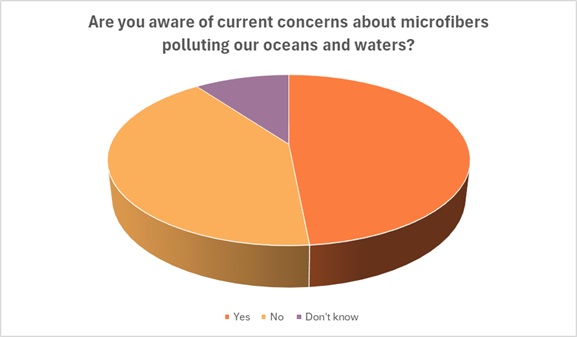It’s that time of year when thoughts of sand and surf take hold. Swimming, jumping the ocean waves, snorkeling, and whale watching are all part of the summer picture. And they’re all activities that take place on the water’s surface. But under the sea is where the vast majority of Earth’s life dwells. And World Oceans Day, celebrated annually on June 8, aims to raise awareness about the ocean’s health and the challenges it faces.
Opting for cotton supports the health and biodiversity of our oceans, safeguarding essential ecosystems for future generations.
Dr. Jesse Daystar, Vice President & Chief Sustainability Officer, Cotton Incorporated
The theme for this year’s World Oceans Day is “Wonder: Sustaining what sustains us.” The purpose of World Oceans Day is to “inform the public of the impact of human actions on the ocean… and unite the world’s population on a project for the sustainable management of the world’s oceans.”
The fashion industry bears some responsibility in ocean’s health challenge. Research shows synthetic textiles like polyester, nylon, and acrylic are the single greatest contributors to engineered microplastics in the ocean, accounting for 35 percent of the total volume. Synthetic fibers, such as polyester and nylon, continue to dominate global textile production. According to the Textile Exchange’s Materials Market Report 2024, global fiber production reached an all-time high of 124 million tonnes in 2023, with virgin fossil-based synthetic fibers accounting for 75 million tonnes. Polyester remained the most produced fiber globally, representing 57% of total fiber production. “Microfibers are the most common form of microplastics polluting the environment, so we need to be paying attention to this,” said Ocean Conservancy’s Dr. Anja Brandon, an environmental engineer and director of plastics policy, in an interview with the Lifestyle Monitor™. “What makes plastic microfibers so troublesome is that – like all plastics – they persist indefinitely.”
Brands should note that this is a concern for consumers. Nearly half (48 percent) are aware of current concerns about microfibers polluting oceans and waters, according to the 2025 Cotton Incorporated Lifestyle Monitor™ Survey. Among those who are aware, 70 percent say they realize much of the microfiber pollution is caused by synthetic microfibers detaching from clothing made from synthetic fibers during washing.

The awareness of microplastics is concerning enough that 70 percent of consumers say it factors into the apparel they buy, according to Cotton Incorporated’s 2022 Laundering & Microplastics Survey. Further, 61 percent of consumers agree that they would prefer their children wear clothing that does not create microplastic pollution, according to the 2024 Cotton Incorporated Lifestyle Monitor™ Survey research.
Cotton Incorporated’s Dr. Jesse Daystar, vice president and chief sustainability officer, said the firm strongly aligns with this year’s World Oceans Day theme by emphasizing cotton’s natural advantages – particularly its biodegradability.
“Our research highlights how cotton fibers break down rapidly in marine environments, significantly reducing their environmental footprint compared to synthetic fibers, which persist for decades, contributing to microplastic pollution,” Daystar said. “Opting for cotton supports the health and biodiversity of our oceans, safeguarding essential ecosystems for future generations. Choosing cotton over petroleum-based synthetic fibers like polyester directly helps protect our oceans by reducing the release of harmful microplastics. Synthetic fibers shed tiny plastic particles with each wash, which infiltrate marine ecosystems and potentially impact wildlife. In contrast, cotton fibers biodegrade naturally, minimizing their environmental impact and actively supporting healthier, cleaner oceans.”
Mary Ankeny, Cotton Incorporated’s vice president of product development and implementation operations, explained how the company supports the “sustaining what sustains us” theme of World Oceans Day.
“By promoting advances in cotton varieties, farming practices, soil health, and reductions of inputs such as water, energy and chemistry in textile processing, Cotton Incorporated is actively promoting several of the World Oceans Day themes,” Ankeny said. “Also, since cotton is made from cellulose, it breaks down in the environment – including in ocean water – thanks to microbes that use its sugar-based structure as food. In contrast, polyester is made from fossil fuels and doesn’t biodegrade, as ocean organisms can’t break it down. As a result, polyester fibers can accumulate and may pose long-term impacts to marine ecosystems.”
HyperNatural, a sustainable fabrics and apparel company, is putting its focus on natural fibers for all its offerings.
“People love the feel of natural fibers, but most don’t realize their ‘performance’ tee is actually plastic,” said HyperNatural’s Chris Kolbe, founder, in an interview with the Lifestyle Monitor™. “Polyester, nylon, spandex, it’s all petroleum based. It’s cheaper, but it comes at a huge cost to our environment. We’re proving that you don’t need plastic to get performance. When people realize their clothes are polluting the ocean and possibly their bodies, they want better options. That’s why we exist. Natural fibers like ours don’t last hundreds of years – they break down the way nature intended. We believe clothes should always be comfortable, natural and with tangible performance…never at the planet’s expense.”
That ethos would likely appeal to today’s consumers, the majority of whom (76 percent) say they’re motivated to take sustainable/environmentally friendly actions, according to Cotton Incorporated’s 2023 Global Sustainability Survey. This is because they have environmental concerns that span from changing temperatures (45 percent) to water contamination (41 percent).
Until the industry changes its reliance on synthetics, the Ocean Conservancy’s Brandon says the most effective way to address all microfibers is by adding filters to washing machines. “They already exist on dryers – and you can see how much gets collected by clearing your filter – so we’re hopeful this will be the next move from appliance makers,” she said.
Meanwhile, Robert Ossant, fashion historian, writer and author, says deeper issues like synthetic overuse and mass production need to be addressed by the fashion industry.
“Consumers can influence demand, but real change needs to come from industry leaders,” Ossant told the Lifestyle Monitor™ in an interview.. “If consumers understand the materials and the consequences, this can help drive change – so education, awareness and industry openness are key.”
